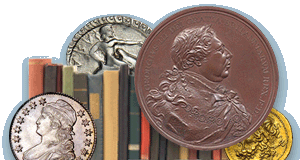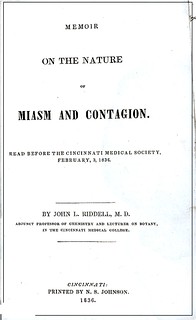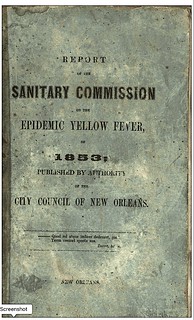
PREV ARTICLE
NEXT ARTICLE
FULL ISSUE
PREV FULL ISSUE
DR. RIDDELL: THE MELTER AND THE PLAGUESMichael E. Marotta submitted this article on numismatic author Dr. John Leonard Riddell's early advocacy for germ theory. Thanks! I wasn't aware of this. -Editor The Melter and the Plagues Dr. John Leonard Riddell was chief melter of the New Orleans Mint 1839 to 1848. In that capacity, he saw many counterfeit Mexican 8 reales silver coins. He catalogued them in his Monograph of the Silver Dollar (1845). Riddell also held two medical doctorates (the first of which he renounced as worthless), and invented the binocular microscope while teaching chemistry at the Louisiana Medical College (now Tulane University). Riddell was a firm advocate for the germ theory of disease a generation before Louis Pasteur and Joseph Lister. In those days, disease was attributed to "miasmas" or bad airs.
"I claim for the corpuscles cause malarious and infectious maladies, trans-microscopic as they are, the humble rank of belonging near the lower confines of organic nature. Perhaps they hold nearly the same grade in respect to animate and sentient beings, which the more simple and minute of Fungi and Algae do to the more perfect tribes of vegetables." Citing the Danish naturalist Otto Friedrich Müller (appearing as "Muller") Riddell wrote "... myriads of these little creatures always make their appearance in fermenting infusions of animal or vegetable matter. They are by no means, however, confined to such infusions, being frequently met with on the leaden tiles of houses..." Not everything in that monograph will resonate with current science. Much was not yet known. But it is clear that Riddell identified microscopic organisms as the cause of disease. That statement envelopes two complementary truths. Others agreed that the organisms appear. Many people—including civic authorities—accepted the theory of spontaneous generation: worms congeal out of mud; maggots precipitate from manure. And Riddell's 1835 Monograph hinted at that. No matter how purified a medium seems, after some time, microscopes reveal the living things within it. Cogently, however, Riddell consistently maintained that the organisms were always there undetected. Moreover, those organism are the causes of diseases, not consequences. Germs do not bloom as a result of miasma. The miasma theory was still operative 20 years later when Riddell was among the civic leaders of New Orleans. In 1853, having been an official at the branch Mint as well as a lecturer at the Medical College of Louisiana, Riddell was enlisted to serve on a committee of savants to fight an outbreak of yellow fever. Serving with him were the mayor, Abdiel Daily Crossman, Dr. Edward Hall Barton (former dean of the Medical College), Dr. Anthony Forster Axson, (former professor of physiology at the Medical College) and medical doctors S. D. McNeil and J. C. Simonds. Their finding were compiled into a 542-page volume, Report of the Sanitary Commission on the Epidemic Yellow Fever of 1853: Published by Authority of the City Council of New Orlean (printed by the Picayune, 1854). From that report:
"2d.--To inquire into the subject of sewerage and common drains, their adaptability to the situation of our city, and their influence on health. "3d.--To inquire into the subject of quarantine, its uses and applicability here, and its influence in protecting the city from epidemic and contagious maladies, and "4th.--To make a thorough examination into the sanitary condition of the city, into all causes influencing it, in present and previous years and to suggest the requisite sanitary measures to remove or prevent them and into the causes of yellow fever in ports and other localities having intercourse with New Orleans." Axson and McNeil were assigned the first task. Riddell was given the second. Simonds investigated the efficacy of quarantine. Barton reported on the sanitation in the city. They had some clue that the open pits of garbage in ponds and puddles of water were deleterious to health. And certainly as we know now, draining all those pools of water limited the mosquitos that carried the plague. They knew, also, that people infected with yellow fever could bring it into the city. Dr. Barton associated the fever with the abundance of mosquitoes in the city but also with the abundance of common houseflies (and mold on fruit). It was another generation before Carlos Finlay of Cuba and William C. Gorgas of the United States were able to convince the medical establishment that the mosquito Aedes aegypti was the vector. The Commission stated at the beginning of its Report that yellow fever is preventable; and that it has two causes, atmospheric and "terrene" (terrestrial). Detailed tables of atmospheric pressure and sunlight were compiled and correlated. The city was also cleaned up. For his part, Riddell recommended that the city be flushed with water from the Mississippi River. Waste water could be carried back into the river or be sent into Lake Pontchartrain. Riddell also suggested that the open drains could be covered with clay or stone pipe as had been done in London. Riddell recognized, however, that a complete system of underground sewers with necessary pumping stations was beyond the means of the city to afford. Wayne Homren, Editor The Numismatic Bibliomania Society is a non-profit organization promoting numismatic literature. See our web site at coinbooks.org. To submit items for publication in The E-Sylum, write to the Editor at this address: whomren@gmail.com To subscribe go to: https://my.binhost.com/lists/listinfo/esylum All Rights Reserved. NBS Home Page Contact the NBS webmaster 
|

